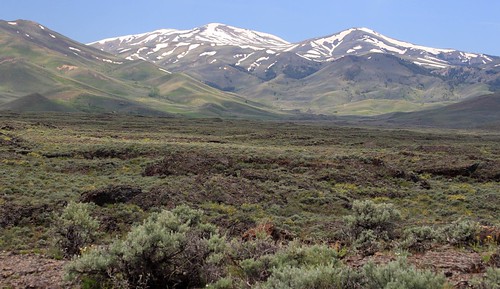 |
| The Arco Desert |
Every work day for over 10 years my father, Royal Wilby Cragun drove from Pocatello, Idaho to the Arco Atomic Energy Site. He was a journeyman electrician from Pocatello Electricians Union local 449. I remember his co-workers Roland Helm, Ronnie Dransfield, and others would car pool. They were electricians and my father told me they were building a prototype for the The Atomic Submarine Nautilus. This was a duplicate of what the seagoing Nautilus would be. The companies mentioned below were common in our dinner conversations.
From WikiPedia: Nautilus was powered by the S2W naval reactor, a pressurized water reactor produced for the U.S. Navy by Westinghouse Electric Corporation. Argonne National Laboratory, together with Westinghouse, developed the basic reactor plant design used in the USS Nautilus after being given the assignment on Dec. 31, 1947 to design a nuclear power plant for a submarine.[6] Nuclear power had the crucial advantage in submarine propulsion because it is a zero-emission process that also consumes no air. The physics critical experiments supporting this design were performed at Argonne. This design is the basis for nearly all of the U.S. nuclear-powered submarine and surface combat ships, and was adapted by other countries for naval nuclear propulsion. The first actual prototype (for the Nautilus) was constructed and tested by Argonne at the S1W facility in Idaho.
My father and his buddies had an air of pride about what they were involved in constructing. One day they returned home very late. Dad was in a state of shock. There had been a terrible accident. Three men had been killed.
For their safety there was always a process, of having on their person a device that measured the radiation level in the ship and on their bodies. They couldn't enter or leave certain areas without those devices measuring safely. The possibility of being contaminated was real. Also, there were instruments all around they could see performing the same function. This day they my father witnessed a terrible accident, a nuclear accident.
As dad told it, a nuclear explosion took place in a portion of the sub. It created radiation that permeated a portion of the ship. My father and Roland Helm were close to the event but safely out of harms way. Another man near the explosion panicked, tore off his protection suit, headed for his car and drove toward Idaho Falls. Two men near the explosion were locked in the area and soon died.
My father and Roland were either asked or volunteered to enter the contaminated area to retrieve the bodies.
They were scrubbed down before and after and received all of the precautions safety standards would demand. Dad told me they retrieved the bodies, and I sensed he felt he and Roland had performed an act of bravery.
He told me as they returned to Pocatello that night they witnessed their co-worker who ran, in his car, the worker dead, and the car being buried there in the desert.
Why my father did not write this story during the time of the event, he was in his 40's, I do not know. Perhaps he was told not to. At times I heard our government brag about our never having a nuclear accident causing deaths. I would confront him, his story was always the same and his hesitation to put it in print real.
I know three men died one day in the Arco desert. I know my father and Roland Helm retrieved the the bodies of two of them. I know that a third man, and his car were buried in that desert. I know we cannot say no one has died from a nuclear incident in our country. I also know that our government, and certain people that worked at Westinghouse Electric Corporation and the Argonne National Laboratory know.
I have no motive to disparage any nuclear program. I just in honor of my father and Roland Helm, who are both dead now, want what few facts of the story I have been given, be published. Here, it's done.
After posting this I found WikiPedia referring to the accident. I also found this video:
I also found this on Encylopedia of Earth dotcom: The NRTS was also the site of the first fatal nuclear accident in the U.S. which killed three men on July 3, 1961. The men were working in the experimental reactor Stationary Low-Power Plant Number 1 when one of the control rods was removed from the reactor improperly. This led to a core meltdown and eventual explosion of the reactor.
I guess there is confirmation that supports this story. The news stories that say there were no deaths are wrong.
 |
| U S S Nautilus |
I think dad's cancer was before the accident.
ReplyDelete.............also.........
I have letters from his company recognizing the work he did during the retrieval.
Yes, I did some more checking and you are right about the cancer. Would you like to post the letters here?
ReplyDeleteThey're in mom's BofR, I'll get them out in the next couple days and scan & send them to you.
ReplyDeleteRead your email, I sent copies of the letters. (also, dad's birth certificate).
ReplyDelete